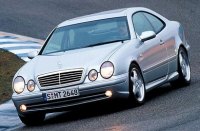 As
many people know, the CLK is simply a C-class coupe with E-class's
headlamps.
Theoretically, C-class donate all its good ingredient to the CLK, such
as rear-wheel-drive transmission, front double wishbones and rear
multi-link
suspensions. Also theoretically, the stiffer spring and damper setting,
lower ride height and lower roofline can sharpen its handling, while
the
variety of engines, from SLK's 2.3-litre
Kompressor four to C55's mega
V8, should place the CLK in multiple segments competitively. As
many people know, the CLK is simply a C-class coupe with E-class's
headlamps.
Theoretically, C-class donate all its good ingredient to the CLK, such
as rear-wheel-drive transmission, front double wishbones and rear
multi-link
suspensions. Also theoretically, the stiffer spring and damper setting,
lower ride height and lower roofline can sharpen its handling, while
the
variety of engines, from SLK's 2.3-litre
Kompressor four to C55's mega
V8, should place the CLK in multiple segments competitively.
Sadly, all these theoretical advantages didn't really came true. Besides the odd headlamps, we have many reasons not to love the CLK. The biggest flaw is the numbness of steering feel, which has been the weakness of any C-class, including AMG models. We know Mecedes' recirculating ball mechanism is not good at providing communication between black top and driver, but in the sportier CLK, which faces sportier rivals than the C-class sedan's, the lack of steering feel becomes more apparent. Take a front-wheel-drive Peugeot 406 Coupe for comparison, you'll find the pricier CLK is so lack of information flowing to the driver's hands. Although weighting is fine, steering response is slow. This devoid it of any driving fun. Tough competition is the next problem. Looking around, there are many good coupes - Peugeot 406 Coupe is not only significantly cheaper, but also performs better in most area, say, handling, ride and styling; BMW 328Ci is perhaps the most complete coupe at the middle price range, elegantly built yet overwhelms the CLK in all area; Jaguar XK8 and XKR makes the CLK430 feels mainstream; Enthusiastic drivers must choose the Porsche 911 Carrera instead of CLK55 AMG. All the CLK models are quite compromised for their target segments:
 The
strength of CLK, for somebody rather than myself, is the elegant
styling
with a 3-pointed star at the nose. Build quality used to be
Mercedes' strength,
but when facing a 328Ci or a XK8, you can hardly call it high quality.
There are sufficient cabin space for 4 adults, in case the rear
occupants
are not too tall. However, 406 Coupe seems more generous about that. The
strength of CLK, for somebody rather than myself, is the elegant
styling
with a 3-pointed star at the nose. Build quality used to be
Mercedes' strength,
but when facing a 328Ci or a XK8, you can hardly call it high quality.
There are sufficient cabin space for 4 adults, in case the rear
occupants
are not too tall. However, 406 Coupe seems more generous about that. |
| The above report was last updated on 16 Mar 2000. All Rights Reserved. |